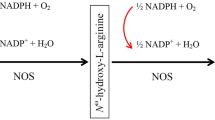Abstract
We investigated role of nitric oxide (NO), prostaglandins (PG) and tyrosine kinase in vascular endothelial growth factor (VEGF)-induced increase in vascular permeability in mouse skin. Subcutaneous injection of VEGF (0.5–2.0 ng/site) induced dose- and time-dependent increase in vascular permeability at the injection site determined by a leakage of Pontamine sky blue. VEGF (1 ng/site)-induced dye leakage was partially inhibited by NG-nitro-l-arginine methyl ester (an inhibitor for both constitutive and inducible NO synthase) (5 and 10 mg/kg, i.v.) and by aminoguanidine (a selective inducible NO synthase inhibitor) (5–20 mg/kg, i.v.), but not by an inactive enantiomer, NG-nitro-d-arginine methyl ester (10 mg/kg, i.v.). Pretreatment with an intraperitoneal injection of indomethacin (a nonselective cyclooxygenase inhibitor) (5 mg/kg) or N-(2-cyclohexyloxy-4-nitrophenyl) methanesulphonamide (a cyclooxygenase-2 selective inhibitor) (1–100 μg/kg) almost completely inhibited the effect of VEGF (1 ng/site). Coadministration of PGE2 (3 and 30 nmol/site) with VEGF did not restore the inhibitory effect of indomethacin on VEGF (1 ng/site)-induced increase in vascular permeability. Lavendustin A (a selective tyrosine kinase inhibitor) (10 and 50 μg/kg, s.c.) dose-relatedly inhibited the VEGF (1 ng/site)-induced increase in dye leakage, whereas its negative control, lavendustin B (10 μg/kg, s.c.) had no effect. Another tyrosine kinase inhibitor, genistein (2.5 mg/kg, s.c.) also inhibited the response. Cycloheximide (a protein biosynthesis inhibitor) (35 mg/kg, s.c.) suppressed the response of VEGF (1 ng/site). Histologically, no cellular infiltration was observed in the area of VEGF injection. These results suggest that increased vascular permeability induced by VEGF is mediated by local production of NO and arachidonic acid metabolites other than PGE2, which are most probably produced by inducible NO synthase and cyclooxygenase-2, respectively. Protein tyrosine kinase-mediated phosphorylation and synthesis of any new proteins are likely to be required in this effect of VEGF in mouse skin.
Similar content being viewed by others
Author information
Authors and Affiliations
Additional information
Received: 18 November 1996 / Accepted: 30 May 1997
Rights and permissions
About this article
Cite this article
Fujii, E., Irie, K., Ohba, Ki. et al. Role of nitric oxide, prostaglandins and tyrosine kinase in vascular endothelial growth factor-induced increase in vascular permeability in mouse skin. Naunyn-Schmiedeberg's Arch Pharmacol 356, 475–480 (1997). https://doi.org/10.1007/PL00005079
Issue Date:
DOI: https://doi.org/10.1007/PL00005079




